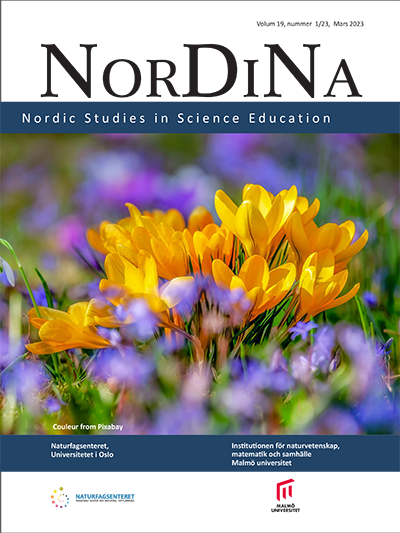Students’ explanations of a complex natural phenomenon using mathematical modeling as a design feature in a model-based inquiry unit
DOI:
https://doi.org/10.5617/nordina.8965Abstract
This research investigates the ways in which mathematical modelling as a design feature support or constrain students’ understandings and explanations of a complex natural phenomenon and how students experience the relevance of mathematical modelling in a model-based inquiry (MBI) unit. To support lower secondary students in using mathematical modelling, we developed an MBI unit based on a complex natural phenomenon, a cloudburst event, in which mathematical modelling was essential to understanding and explaining the phenomenon. The research took place in two Danish schools and the unit comprised 12 lessons over a period of one week. The sample group consisted of 40 students in the 14–16 years age group. For the analysis of the students’ mathematical modelling, the research used an adaptation of the modelling cycle proposed by Blum and Leiß (2005) to interpret the students’ artefacts. A subset of participants (n = 7) was also interviewed about their models to gain insights into how students experience the relevance of mathematical modelling in the MBI unit. Results show that the majority of the students – 37 out of 40 – were able to understand the mathematical problem from the anchoring phenomenon and model the phenomenon from a mathematical perspective, but we also see that a small number of students have problems in completing all the facets of the mathematical modelling cycle and are not able to validate the solution of the mathematical problem in relation to the anchoring phenomenon. Students expressed that their own modelling process along with the mathematical modelling helped them better understand the various elements of the anchoring phenomenon.
Downloads
Published
Issue
Section
License
Authors who publish with this journal agree to the following terms:- Authors retain copyright and grant the journal right of first publication with the work simultaneously licensed under a Creative Commons Attribution License that allows others to share the work with an acknowledgement of the work's authorship and initial publication in this journal.
- Authors are able to enter into separate, additional contractual arrangements for the non-exclusive distribution of the journal's published version of the work (e.g., post it to an institutional repository or publish it in a book), with an acknowledgement of its initial publication in this journal.
- Authors are permitted and encouraged to post their work online (e.g., in institutional repositories or on their website) prior to and during the submission process, as it can lead to productive exchanges, as well as earlier and greater citation of published work (See The Effect of Open Access).


